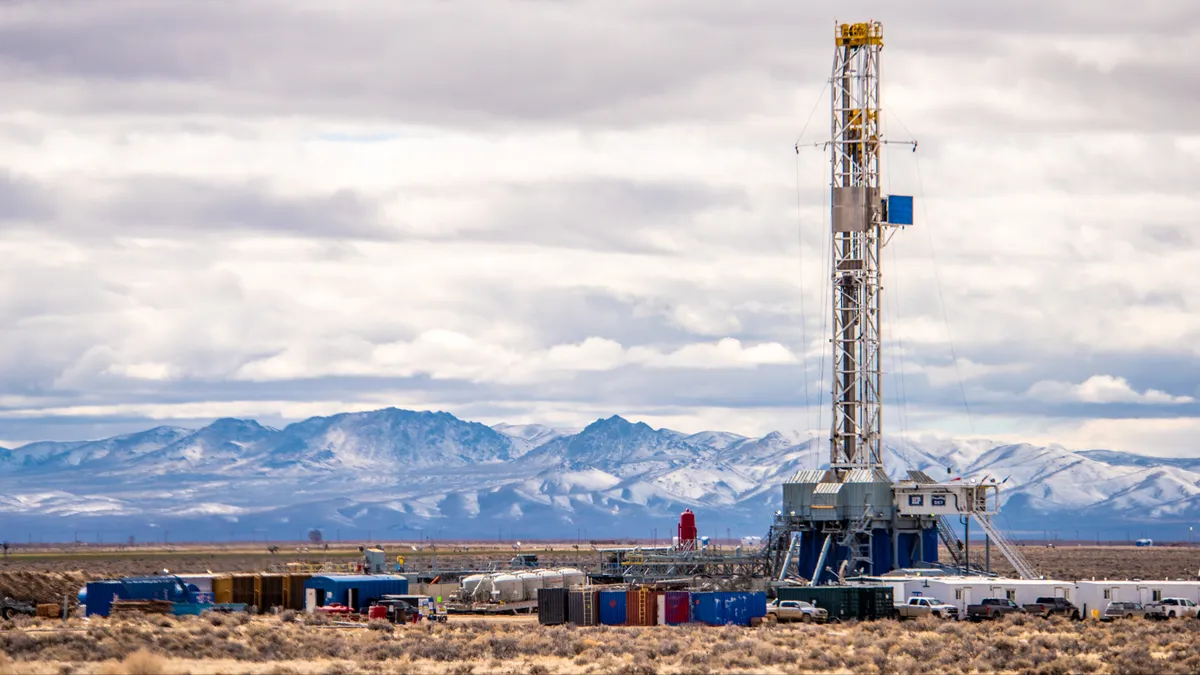In a move that could open a path for widespread 24/7 clean energy, startup Fervo Energy built and tested a pilot enhanced geothermal system, or EGS, that it expects will supply Google with about 4 MW by the end of the year.
Using fracking techniques developed by the oil and gas industry, the first-of-its-kind Project Red showed Fervo can develop geothermal projects in areas that weren’t viable with traditional geothermal technology, Tim Latimer, CEO, said Thursday in an interview.
There are “hundreds of sites across the western United States that now fit our criteria that can be developed economically,” he said.
There are about 3.7 GW of U.S. geothermal capacity, but it could grow to 90 GW-electric by 2050, according to the Department of Energy. Fervo aims to install and own about 1 GW by the end of this decade.
In a step towards its goal, in northern Nevada, Fervo drilled two horizontal wells in hardrock and created fracture zones between them, according to the company’s Tuesday report on the project. The company circulated fluid between the wells over 37 days to recover heat from the rock formation.
The project is the most productive EGS system ever built in terms of flow rate and its 3.5-MW electric power equivalent, Latimer and Jack Norbeck, Fervo’s chief technology officer, said in the report.
The project’s results are a “historic breakthrough” for geothermal power, but Fervo still has much work ahead, according to Mark McClure, CEO of ResFrac, a firm that develops hydraulic fracturing simulation software. “Even as they continue to achieve technical success, they will need to demonstrate the commercial model — that they can secure funding, execute, and drive down costs to achieve long-term profitability,” he said Wednesday in a review of the project’s results.
If EGS is shown to be viable, shale companies will likely become involved in the sector, McClure said, noting Devon Energy in April invested $10 million in Fervo. McClure advises Fervo.
Fracking techniques offer benefits for geothermal projects
So-called fracking could provide major benefits for geothermal projects, according to Fervo.
“Horizontal drilling has the potential to improve geothermal project economics significantly by providing greater access to the target reservoir volume, more consistent flow rates, more uniform flow distribution throughout the reservoir volume, and greater total heat transfer surface area,” Latimer and Norbeck said in the report.
Fervo intends to move quickly from the pilot project stage to developing commercial projects.
The Houston-based company has power purchase agreements with three sets of community choice aggregation organizations.
Fervo has started drilling for a 90-MW initial phase on a project in Beaver County, Utah, that will supply two of the groups with 53 MW, according to Latimer. Deliveries under one PPA are expected to begin in the second quarter of 2026, and the other contract starts two years later.
Latimer also expects Fervo to break ground next year on a project in Churchill County, Nevada, that is tied to a 40-MW PPA that calls for power deliveries to begin in late 2026.
Those contracts are driven by a 2021 California Public Utilities Commission reliability procurement decision that included a mandate that utilities and other load-serving entities buy a total of 1 GW of firm, emissions-free energy starting in 2026.
Noting that California’s investor-owned utilities must meet that obligation, Latimer said Fervo has been in talks with utilities for potential offtake agreements. Pacific Gas & Electric has a 238.5-MW requirement, Southern California Edison must buy 388.5 MW and San Diego Gas & Electric needs to acquire 44.5 MW.
Outside California, Fervo is also talking with Western utilities, which face a growing need for capacity as coal-fired power plants retire and the outlook for hydroelectric generation has grown less certain as the weather grows more extreme, according to Latimer.
“Firm, clean power has really shown to be quite valuable over the last few years because of these reliability issues and climate goals,” Latimer said.
In addition, firm, clean power will be needed to cost-effectively meet decarbonization goals, Latimer said, citing studies such as one by the National Renewable Energy Laboratory that indicate firm power must make up the 10% to 20% of the resource mix that can’t easily be met by wind, solar and conventional storage technologies.
Also, Fervo has a development agreement with Google, which has committed financing and offtake support to the geothermal company’s early projects, he said.
Fervo expects prices to fall
Currently, the cost of power produced from Fervo’s projects is “significantly” higher than the DOE’s goal of $45/MWh by 2035 for EGS, according to Latimer.
It will take years to scale up to meet the DOE’s price target, but Fervo’s pilot project shows the company is on track to hit that goal, he said.
Fervo probably offers the most cost competitive, clean, firm power resource compared to nuclear, advanced nuclear, and natural gas with carbon capture and sequestration, according to Latimer.
Latimer said the pilot project shows that EGSs can be built using available technology, but challenges remain.
On the regulatory front, grid interconnection and transmission are top priorities for Fervo, according to Latimer. “We have to fix the grid, he said.
Federal permitting is also a major challenge, according to Latimer.
Federal tax credits for geothermal systems made available through the Inflation Reduction Act are “helpful,” but the tax equity market for geothermal is less mature than for more established technologies like wind and solar, according to Latimer.
Fervo is aggressively pursuing opportunities through the expanded authorization for the DOE’s Loan Program Office and the creation of the department’s Office of Clean Energy Demonstration, he said.
As of February, Fervo had raised over $180 million from investors such as Breakthrough Energy Ventures, Capricorn and DCVC, and government institutions including Berkeley National Laboratory, ARPA-E and DOE’s Office of Energy Efficiency and Renewable Energy.






















